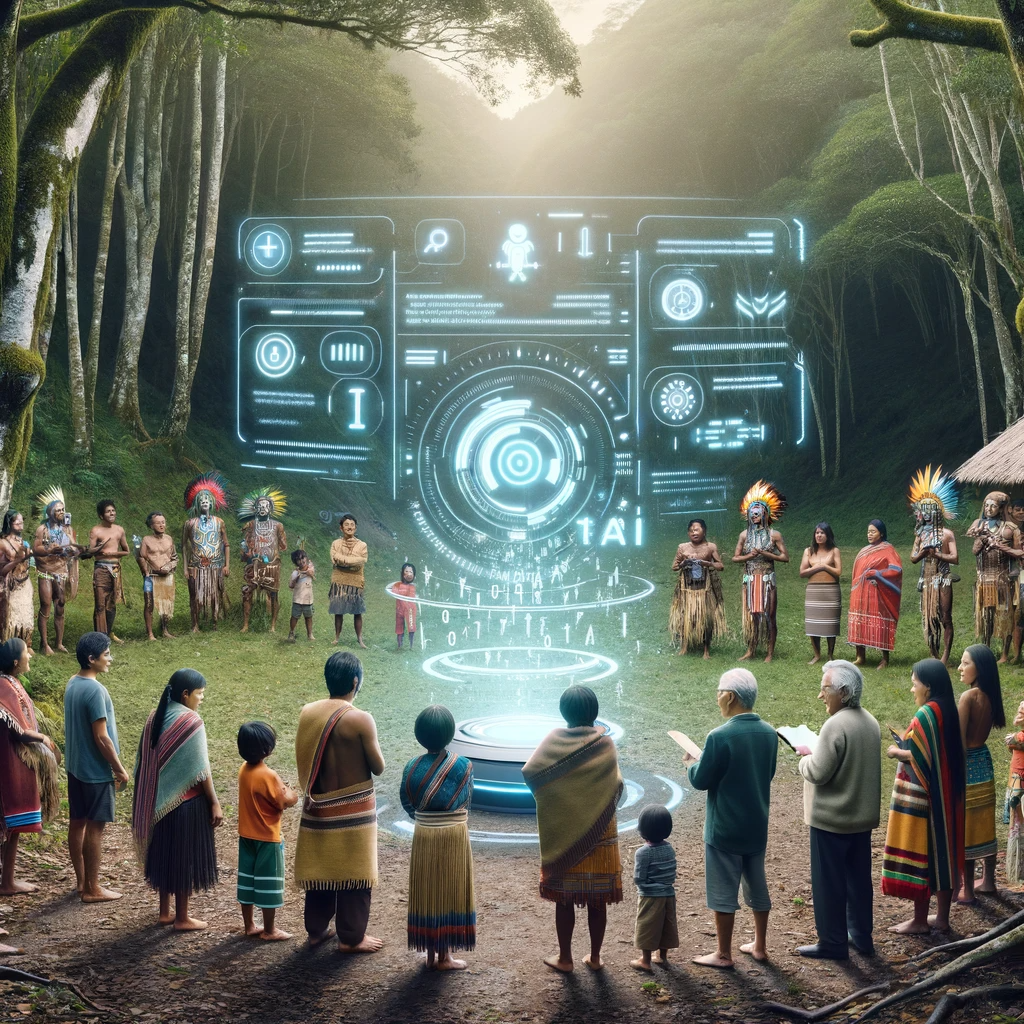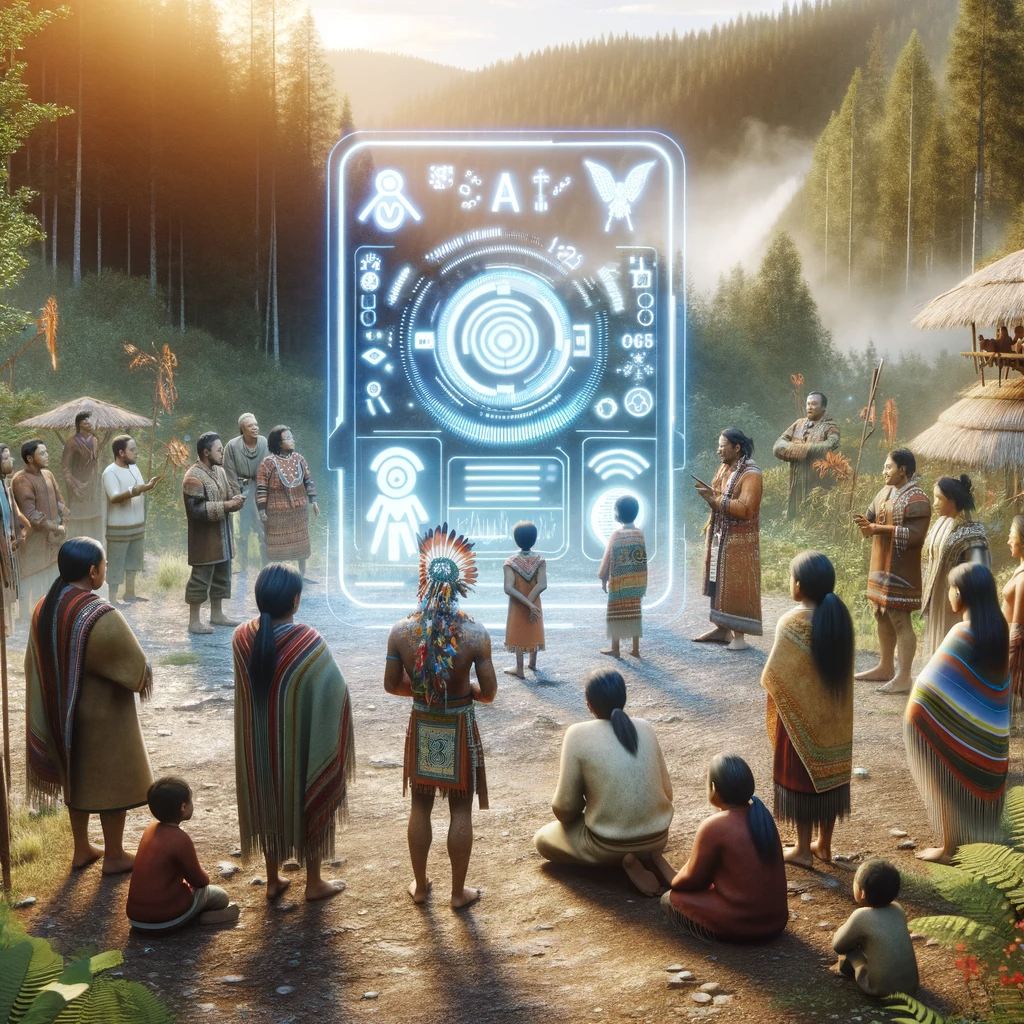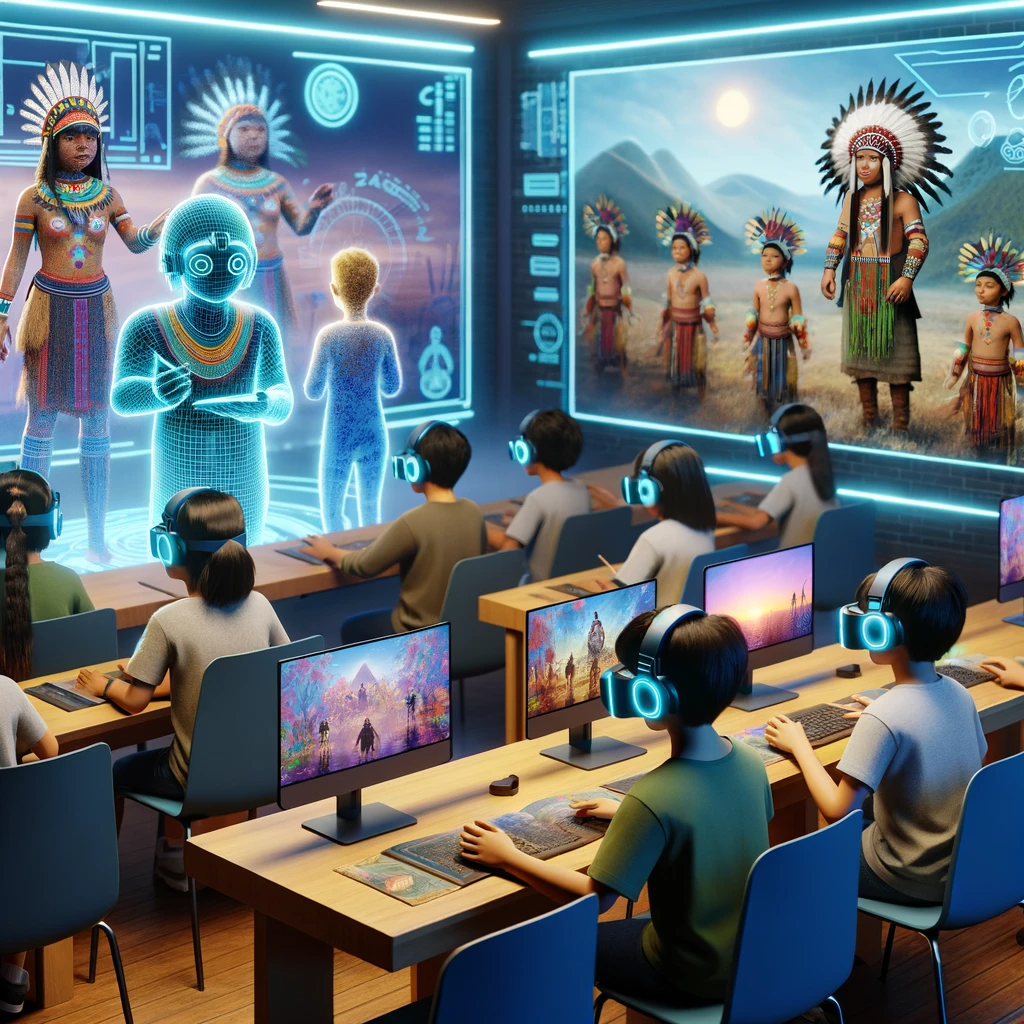Language is not merely a means of communication; it is the vessel of culture, history, and identity. For indigenous communities around the world, their languages are sacred repositories of traditional knowledge, storytelling, and unique worldviews. However, the rich tapestry of indigenous languages and cultures faces a pressing challenge – the threat of extinction. As these languages and cultural heritage fade into obscurity, we stand to lose not only linguistic diversity but also invaluable insights into the human experience.
In this era of technological advancement, there emerges a beacon of hope for the preservation and revitalization of indigenous languages and cultures – Artificial Intelligence (AI). AI, with its capacity for language analysis, transcription, and interactive learning, has begun to play a pivotal role in the quest to safeguard these endangered treasures. This article embarks on a journey to explore how AI tools are rising to the challenge of documenting, preserving, and revitalizing indigenous languages and cultural heritage.
The significance of indigenous languages and cultures cannot be overstated. They carry the wisdom of generations, hold the keys to sustainable relationships with the natural world, and offer profound insights into the human condition. Yet, the UNESCO Atlas of the World’s Languages in Danger reveals that a significant number of indigenous languages are critically endangered, with some facing the bleak prospect of extinction within a generation. The erosion of linguistic diversity also represents the erosion of cultural diversity and the potential loss of innovative, sustainable practices.
The challenges of language preservation are multifaceted, including limited resources, the oral nature of many indigenous languages, and the dwindling number of fluent speakers. It is against this backdrop that AI steps onto the stage as a technological ally, offering innovative solutions to address these challenges. AI-powered speech recognition and transcription tools, language learning applications, and cultural heritage preservation techniques are beginning to make a profound impact.
As we delve into the fascinating intersection of AI and indigenous languages and cultures, this article will explore the importance of these languages, the urgency of their preservation, and the multifaceted role AI plays. We will examine AI’s capacity to document languages, assist in their revitalization, and preserve cultural heritage. While celebrating the promise of AI, we will also navigate the ethical considerations, challenges, and the vital need for community-driven efforts.
In a world that is increasingly interconnected yet paradoxically at risk of cultural homogenization, the preservation of indigenous languages and cultures is not only a duty but also a testament to our commitment to diverse and vibrant human expressions. As we embark on this enlightening journey through the realm of AI and linguistic preservation, we invite you to discover the transformative potential of technology in preserving the invaluable voices of indigenous communities for generations to come.
The Importance of Indigenous Languages and Cultures
Indigenous languages are not mere linguistic constructs; they are living embodiments of cultural heritage and identity. Within these languages reside centuries of wisdom, passed down through oral traditions, and deeply intertwined with the natural environment. Indigenous languages hold the keys to sustainable relationships with ecosystems, ancestral knowledge, and unique worldviews that enrich our understanding of the human experience.
These languages are the keepers of traditional stories, passed down from generation to generation, offering insights into indigenous cosmology, spirituality, and morality. They serve as repositories of historical events, navigational wisdom, and the intricate interplay between humans and their surroundings.
Cultural practices, rituals, art forms, and music are intimately connected to indigenous languages. They shape and reflect the distinctive identities of these communities. The loss of a language represents more than just the fading of words; it signifies the erosion of cultural diversity, the dilution of collective memory, and the weakening of community bonds.
The preservation of indigenous languages and cultures is not just a matter of linguistic diversity; it is a commitment to the protection of human heritage, the celebration of unique worldviews, and the promotion of cultural resilience. As indigenous communities strive to preserve their languages and cultural traditions, the emergence of AI as an ally in this endeavor offers a glimmer of hope for the future.
The Challenge of Endangerment
Despite the cultural richness encapsulated within indigenous languages, they face a stark and looming challenge – the threat of extinction. The factors contributing to the endangerment of these languages are multifaceted. They include historical oppression, forced assimilation, migration to urban areas, and the dominance of majority languages.
Statistics reveal the urgency of the situation. The UNESCO Atlas of the World’s Languages in Danger classifies languages into various categories of endangerment, from “vulnerable” to “critically endangered.” Some languages, with only a handful of elderly speakers, teeter on the brink of extinction. The loss of these languages represents the irreplaceable erasure of unique cultural knowledge, narratives, and worldviews.
The effects of language endangerment extend beyond the linguistic realm. Indigenous communities that lose their languages also risk losing their cultural identities, spiritual connections, and the traditional knowledge needed for sustainable practices. The preservation of these languages has thus become a race against time.
AI as a Tool for Documentation
In the battle to preserve indigenous languages, AI emerges as a powerful tool for documentation. AI-driven speech recognition and transcription tools have the capability to convert spoken words, often present in oral traditions, into written records. This technology is a game-changer, allowing linguists and community members to document and archive indigenous languages systematically.
Moreover, AI-powered language documentation tools can assist in analyzing linguistic patterns, identifying vocabulary, and even reconstructing grammatical structures. These tools complement the efforts of field linguists and community members who work tirelessly to capture the nuances of their languages.
Case studies from around the world showcase how AI is being employed to document indigenous languages that have limited or no writing systems. These efforts are vital in creating comprehensive language resources that can serve as a foundation for future revitalization endeavors.

AI-Powered Language Revitalization
The preservation of indigenous languages goes beyond mere documentation; it involves revitalization efforts to ensure that these languages continue to be spoken and passed down to younger generations. AI is increasingly playing a pivotal role in language revitalization initiatives.
AI-powered language learning applications are making language acquisition more accessible and engaging. These applications use interactive technologies, chatbots, and virtual tutors to create immersive language-learning experiences. Indigenous communities are harnessing these tools to design language courses tailored to their specific needs, incorporating traditional stories and cultural context into the learning process.
One of the remarkable features of AI language learning tools is their adaptability. They can cater to different learning styles and paces, making language learning more inclusive. This adaptability is particularly crucial for indigenous languages, where learners may come from diverse backgrounds and age groups.
Chatbots and virtual language tutors powered by AI are available 24/7, offering learners constant support and opportunities for practice. This accessibility is essential for indigenous communities with dispersed populations, enabling individuals to engage with their languages regardless of geographical constraints.
Across the globe, success stories abound where AI-driven language revitalization programs have rekindled interest in indigenous languages. Indigenous youth, who may have previously felt disconnected from their heritage, are now embracing their languages with enthusiasm and pride.
Preservation of Cultural Heritage
Preserving indigenous languages goes hand in hand with safeguarding cultural heritage. Beyond language itself, cultural heritage includes traditional stories, music, art, and artifacts. AI technologies are also playing a crucial role in the preservation of these cultural treasures.
AI-based digitization techniques are being employed to preserve cultural artifacts and historical documents. High-resolution scanning, 3D modeling, and image recognition enable the creation of digital archives that can withstand the test of time. This digitization ensures that culturally significant items are not lost to decay, theft, or natural disasters.
AI is also being used to restore damaged cultural artifacts, such as ancient manuscripts or artworks. Image analysis algorithms can reconstruct missing parts, enhance faded colors, and remove imperfections, thus revitalizing cultural heritage.
Furthermore, AI-driven language documentation efforts extend to the preservation of traditional stories and oral histories. Automated transcription and translation tools assist in transcribing and translating these narratives into written form, ensuring their accessibility to future generations.
As AI contributes to the preservation of indigenous languages and cultural heritage, it also empowers indigenous communities to reclaim their stories, art, and traditions. This revitalization process strengthens cultural identities and fosters a sense of belonging among community members.
Challenges and Ethical Considerations
While AI offers promising solutions for language preservation and revitalization, it is not without its challenges and ethical considerations. The adoption of AI in indigenous communities must be approached with sensitivity and caution.
Issues related to data ownership, consent, and representation are paramount. Indigenous communities must have ownership and control over the data and content generated through AI language documentation and revitalization projects. Consent and collaboration with community members are essential to ensure the ethical use of AI technologies.
AI-driven language documentation tools may also face challenges in accurately capturing the intricacies of indigenous languages, especially when they are tonal or feature unique phonological aspects. Ensuring the authenticity and accuracy of transcriptions and translations is critical to preserve linguistic integrity.
Moreover, there is a risk of over-reliance on AI, potentially sidelining human language experts and community members. Balancing the role of AI as a tool with the importance of human involvement is crucial for the success of these initiatives.
Collaborative Initiatives
The preservation and revitalization of indigenous languages and cultures through AI-powered tools often thrive in collaborative environments. Partnerships between AI researchers, linguists, and indigenous communities are essential for creating effective and culturally sensitive language preservation projects.
Community-driven initiatives take center stage in these collaborations. Indigenous elders, language speakers, and cultural experts actively contribute their knowledge, stories, and perspectives to the development of AI-driven language tools. Their invaluable input ensures that AI technologies respect the nuances, context, and cultural significance of indigenous languages.
These collaborations extend beyond language documentation and revitalization. Indigenous communities are increasingly involved in the design and development of AI applications tailored to their specific linguistic and cultural needs. This ensures that AI tools align with community goals and aspirations.
Furthermore, these partnerships prioritize the ethical considerations of AI projects. Indigenous communities rightfully retain control over their linguistic and cultural data, ensuring that AI technologies are used responsibly and transparently. This community-driven approach empowers indigenous people to harness AI as a tool for cultural preservation on their own terms.
The Future of AI in Language Preservation
The synergy between AI and the preservation of indigenous languages and cultures is an evolving journey. As technology continues to advance, the future holds exciting possibilities for language revitalization and cultural heritage preservation.
AI technologies are expected to become more sophisticated in understanding and interpreting indigenous languages. They will evolve to capture nuances, dialects, and context with higher accuracy, making language documentation and revitalization even more effective.
Innovative language learning applications will continue to improve, offering personalized and engaging experiences for learners. These applications will incorporate AI-driven chatbots and virtual tutors that adapt to the unique needs of indigenous language learners, thereby fostering greater fluency.
AI-driven cultural heritage preservation efforts will also see advancements. Enhanced digitization techniques, improved restoration algorithms, and immersive virtual reality experiences will ensure that cultural artifacts and traditions remain vibrant and accessible.
The democratization of AI tools will enable even smaller indigenous communities to embark on language preservation initiatives. Open-source AI platforms and resources will empower community members to create their own language documentation and revitalization projects, reducing dependency on external assistance.
As we look ahead, the fusion of AI and indigenous language preservation holds the promise of a world where linguistic diversity thrives, cultural heritage is celebrated, and the voices of indigenous communities resound through the ages.

Conclusion
In the tapestry of human existence, indigenous languages and cultures are threads of immeasurable value. They carry the collective wisdom, stories, and traditions of communities that have thrived for centuries. Yet, the relentless march of time threatens to unravel this tapestry, leaving behind gaps in our understanding of the human experience.
Artificial Intelligence emerges as a beacon of hope in this critical endeavor. It offers innovative solutions for documenting, preserving, and revitalizing indigenous languages and cultural heritage. AI-driven language documentation tools, language learning applications, and cultural heritage preservation techniques represent transformative technologies that can reshape the future of indigenous communities.
The urgency of this mission cannot be overstated. With languages on the brink of extinction and cultural traditions at risk of fading away, the time to act is now. Collaborative efforts, community-driven initiatives, and responsible AI use are key to ensuring that indigenous languages and cultures not only survive but thrive.
As we conclude this exploration of AI’s role in preserving indigenous languages and cultures, we are reminded that this journey is not just about technology; it is about humanity’s commitment to diversity, heritage, and the preservation of voices that hold timeless wisdom. With AI as our ally, we step into a future where linguistic and cultural diversity flourishes, and the world is enriched by the vibrant tapestry of indigenous languages and cultures.
